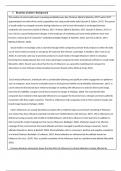1. Business problem: Background
The number of social media users is growing worldwide every day (Virtanen, Björk & Sjöström, 2017) and in 2017,
approximately one-third of the world’s population was using social media daily (Qureshi & Zahoor, 2017). The spread
of social media has changed consumer buying behaviour as well as how information is exchanged between
companies and consumers (Sudha & Sheena, 2017; Virtanen, Björk & Sjöström, 2017; Qureshi & Zahoor, 2017). In
turn, this has caused fundamental changes in the landscape of marketing and social media platforms have now
become a natural part of companies’ marketing strategies (Kaplan & Haenlein, 2010; Qureshi & Zahoor, 2017;
Bjurling & Ekstam, 2018).
Social media is increasingly used as channels through which companies promote their products in which the daily
use of social media increased on average by 39.5 percent (De Veirman, Cauberghe, & Hudders, 2017; Han & Lee,
2016). A commonly used way to promote products on social media is through influencers which is nowadays
becoming increasingly popular due to its many advantages compared to other promotional methods on social media
(Besselink, 2021). Recent years show that the rise of influencers as a powerful marketing tool compared to
alternatives is more intimate and personalised to present brands online (Sinha & Fung, 2021).
Social media influencers, individuals with a considerable following and significant online engagement on platforms
such as Instagram, have become invaluable assets in driving brand visibility and profitability (Glucksmann, 2017). It
can be observed that brands have relied increasingly on working with influencers to build on their brand image,
boost brand credibility, and gain overall brand awareness (Gupta & Mahajan, 2020). The main benefit that
companies have realised is that especially influencers can support the brand to have a stronger and more authentic
connection with their target customers. Therefore, influencers help companies work on their customer loyalty and
brand image (Gupta & Mahajan, 2020).
Macro influencers are usually described as people with a relatively large social network consisting of followers,
over whom they have influence practised normally over 50,000 followers (De Veirman, 2017). Micro influencers are
defined as having accounts with 10,000 to 50,000 followers which they influence in their part time in addition to
their normal life mostly charging less than macro influencers (Bollinger, 2022). Marketers speak of an effective
campaign if they communicate the brand attitudes and have managed to positively change consumers’ brand
attitudes (Newberry, Klemz & Boshoff, 2003). Brand attitudes refer to consumers’ positive and negative evaluations
of a brand (Chetioui, Benlafqih, & Ledbaoui, 2019). Brand attitudes are influenced by the attitude toward an
influencer (Jin et al., 2019). Thus, a positive evaluation of the influencer leads to a positive brand attitude (Besselink,
2021).
Previous literature extensively shows that the effect of influencers on brand attitudes is mainly affected by
, accessibility, authenticity, and expertise (Campbell & Farrell, 2020). In other words, the perceived quality,
authenticity, and credibility of influencers affect the way users perceive the brand promoted by the influencer
(Newberry, Klemz & Boshoff, 2003). Consequently influencer quality, authenticity, and credibility will act as
moderator variables in this research proposal in which their profile and content are analysed.
Content quality can be defined as how well-posted content achieves its purposes, it shows insight into a piece of
content with depth of information (Dabbous & Barakat, 2020). Content quality can also be described as accessibility
which includes readability, formatting, and grammatical correctness from the viewpoint of the message receiver
(Campbell & Farrell, 2020).
Advertising that is perceived as authentic is tied to better attitudes and increased levels of brand trust (Cornelis &
Peter, 2017). Moreover, authenticity is thought to be fundamental to a brand’s status (Napoli, 2014; Shoenberger,
Kim & Johnson, 2020). Thus, authenticity affects the relationship between marketing communication and the brand
attitudes and purchase intentions of consumers (Cornelis & Peter, 2017).
Influencer credibility refers to the process of attitude creation toward a source that determines the effectiveness of
a marketing message (Chetty, 2019). This credibility is also an important factor affecting persuasion effectiveness
(Hovland and Weiss, 1951). If the source has credibility, consumers will trust the message. Thus, credibility is how
much the message reflects reality after the consumer’s evaluation (Wu & Wang, 2011).
Furthermore, this research proposal will be focussed on music festivals in the Netherlands because in general there
is a lack of research on influencer marketing used in music festivals in the Netherlands which will be discussed in the
Academic Relevance. Moreover, there will be a concentration on the festival of Awakenings because after analysing
their influencer marketing efforts on social media it shows that they currently do not make use of influencer
marketing compared to competitors, such as By The Creek and Verknipt. Therefore, Awakenings will face the pain of
missing out on using micro-influencers in their marketing strategy.
Awakenings have been organising techno events for more than 25 years. With over 300.000 visitors a year, they
are one of the biggest in the market, Awakenings has shown to bring the ultimate techno experience (Awakenings,
2021). However, competition, such as By The Creek and Verknipt, are catching up in visitors with Awakenings and
therefore they require new ways of positively affecting the brand attitudes of consumers to stay the market leader in
their segment of techno (Dee & Schans, 2021).
Awakenings require knowing how they should use the level of influencer marketing (Micro vs Macro) to create
positive brand attitudes. Moreover, Awakenings preferably wants to have a positive effect on the level of influencer
marketing (Micro vs Macro) on brand attitudes in which it is possible to strengthen this effect by emphasising





